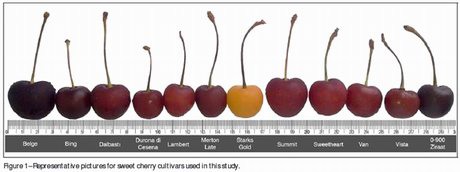Turkey is one of the main sweet cherry producer worldwide (approximately 21.3%) and ranked 1st place in 2012 with sweet cherry production of 480748 metric tons, followed by United States, Iran, and Italy (FAO 2014). Turkey, the 2nd largest cherry exporter after United States, exports part of these cherries (46477 metric tons) especially to European countries (for example, United Kingdom, Germany, and Holland; FAO 2014).
Given this economical importance of sweet cherry, there are recent attempts to extend the production of other cultivars. The most popular sweet cherry variety cultivated in Turkey is 0–900 Ziraat followed by other types like Bing, Lambert, Noir De Guben, Stella, Van, Bigarreau, Edirne, Turfanda, and Karabodur. However, there are only a few reports available on 0–900 Ziraat and no detailed study was performed on chemical constituents and physical properties of sweet cherry cultivars grown in Turkey.

Click here to enlarge this picture.
Ali Adnan Hayaloglu and Nurullah Demir, scientists at Inonu University of Malatya (Turkey) have investigated the physical characteristics, antioxidant activity and chemical constituents of 12 cultivars of sweet cherry grown in Turkey.
Scientists conclude: "This is the first study on the chemical composition and physical properties of most sweet cherries grown in Turkey. Results showed that the chemical composition and physical properties of sweet cherries were significantly influenced by cultivars. There were some similarities between cultivars. For instance, malic acid and glucose were the most abundant organic acid and sugar in the sweet cherries, respectively, regardless of cultivars. However, total phenolics and anthocyanin contents, antioxidant activity, color parameters, and so on, were highly specific for each cultivar. Ultimately, with this study we intend to inform consumers about the health beneficial substances of sweet cherry cultivars."
Source: Ali Adnan Hayaloglu and Nurullah Demir, 'Physicochemical characteristics, antioxidant activity, organic acid and sugar contents of 12 sweet cherry (Prunus avium L.) cultivars grown in Turkey', Marzo 2015, Journal of Food Science, Vol.80 (3), pages C564-C570. http://onlinelibrary.wiley.com/doi/10.1111/1750-3841.12781/abstract
Contacts:
Ali Adnan Hayaloglu
Department of Food Engineering, Engineering Faculty, Inonu University
Malatya, Turkey
Email: [email protected]










